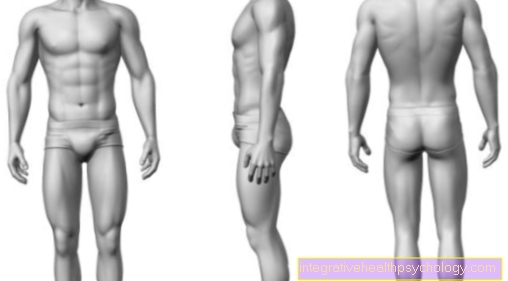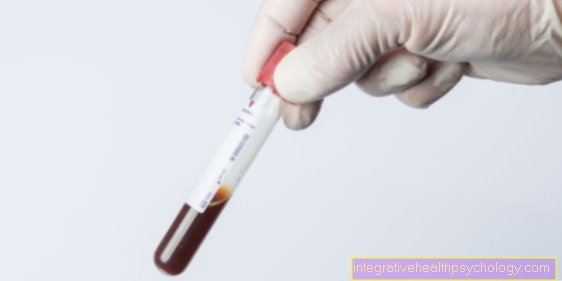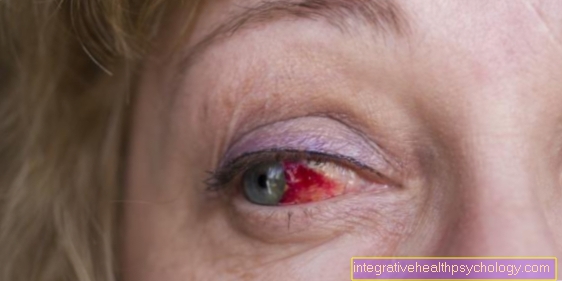The RS virus
What is an RS virus?
The respiratory syncytial virus, RS virus or RSV for short, belongs to the paramyxoviruses. It is transmitted via a droplet infection. This means that the pathogen is transmitted to other people via small droplets that are formed when speaking, coughing or sneezing.
An increase in infections with the RS virus can be observed, especially in the winter months. The RS virus is highly contagious and children in particular are infected with the virus. In these, it triggers inflammation of the lower respiratory tract, which manifests itself among other things with the symptoms of fever and shortness of breath.
You might also be interested in this article: The viral cold

Symptoms of RSV infection
The RS virus does not have any specific symptoms by which an infection can be recognized immediately. Rather, a wide range of symptoms of the respiratory tract occurs, which can also occur with infections with other pathogens. In children, a major symptom of RS virus infection is a high fever. There are also signs of shortness of breath:
- These are, for example, an increased breathing rate and greater effort when breathing. Other signs of shortness of breath can be observed, especially in young children.
- In the area of the ribs, the skin can be drawn inwards in the spaces between the ribs. In order to compensate for the shortness of breath, the body tries to draw more air into the lungs by creating a stronger negative pressure when inhaling. This creates the named collections.
- In addition, one can observe a rapid movement of the nostrils both during inhalation and exhalation. This helps to enlarge the airways and allows for greater airflow.
- In addition, the head is often tucked back in order to expand the larynx and allow a greater influx of air.
- The exhalation phase can be prolonged with this infection.
- The lack of oxygen can cause the lips, among other things, to turn bluish.
In addition to the changes in breathing, a cough may develop. Children may notice a reduced appetite and runny nose in the early stages of the infection.
Course of the disease in RSV
The onset of the disease in toddlers and infants is initially characterized by loss of appetite and a runny nose. Another early sign is inflammation of the throat area, which can manifest itself with a sore throat.
After 1-3 days, the inflammation spreads along the airways. Then there is an infection first of the upper and later the lower respiratory tract. At this point the symptoms of shortness of breath show up and the fever begins.
If the disease progresses further, pneumonia can occur. In older children, the disease can only go as far as inflammation of the upper respiratory tract and cannot spread any further.
As a late complication, acute otitis media can develop in some children, for which the virus is also the cause. With this complication, there is a risk that the middle ear will also be infected with a bacterium. This double infection is called superinfection and is often difficult to treat. After a severe course, persistent hypersensitivity of the airways can occur. This manifests itself in the fact that the airways contract reflexively even with minor stimuli and breathing is difficult.
incubation period
The incubation period is between two to eight days. It describes the time between being infected with the RS virus and the onset of symptoms.
Therapy of RSV
There is no specific therapy against the virus, so the therapy primarily includes measures to alleviate the symptoms. For small children and infants, the therapy is carried out in the hospital. As a general measure, they are given oxygen and a drug that dilates the airways. If independent breathing is no longer sufficient to absorb enough oxygen, a mask that supports breathing must be used. In extreme cases, mechanical ventilation must be carried out. Furthermore, care is taken to ensure that sufficient fluid is given, as this helps to liquefy the secretion in the nasopharynx. This is the only way for it to run smoothly and no longer block the airways.
Ribavirin, an anti-viral drug, is only recommended in exceptional cases. Studies have not shown that patients on ribavirin therapy had better disease progression and fewer complications. It is therefore no longer part of standard therapy. Inhaling corticosteroids is also no longer recommended. Administration of corticosteroid steroids via venous access can improve the acute symptoms. However, this must be weighed against the possible side effects.
Further information can also be found at: Therapy of a cold - tips and tricks
Duration of an RSV infection
An uncomplicated infection with the RS virus heals completely after about 3-12 days. In the first few days of the disease, there is an infection of the upper respiratory tract. In the course of 1-3 days, inflammatory reactions in the lower airways and the symptoms described occur. However, some of the symptoms, such as the cough, can persist for weeks, even if all the other symptoms have already subsided.
This information relates particularly to small children, as adults with a normal immune system usually do not experience any symptoms with an RSV infection and it is therefore silent. Of course, the duration of the disease also depends on the severity and can be extended if complications develop. No general statement about the duration can be made here. Even with immunosuppressed patients, it is difficult to make a statement about the duration, as many factors have an influence on them.
Who is particularly sick with RSV?
Small children and infants in the 3rd and 4th month of life in particular are particularly likely to develop the RS virus. The RS virus is the most common respiratory tract infection in infants and young children.
During epidemics - i.e. in the periods in which the infection with the RS virus occurs more frequently - day care centers and children's clinics are particularly affected. Furthermore, premature babies and small children with congenital heart defects or diseases of the respiratory tract, such as asthma, are particularly affected. Premature babies have not received sufficient nest protection from their mother, so that they can contract the RS virus in the first few weeks of life. This is life-threatening for them.
Adults are less likely to get the RS virus because the immune system fends off the virus before symptoms can occur. However, adults with frequent contact with small children have an increased risk of developing the disease. Adults whose immune systems have been weakened for a variety of reasons are at higher risk of contracting the RS virus. This includes patients with immunosuppression, such as occurs after the administration of chemotherapy drugs, or people with chronic diseases of the heart or lungs.
How dangerous is RSV during pregnancy?
An infection with the RS virus during pregnancy poses no danger to both mother and unborn child. The prerequisite for this is that there is no immune system disorder in the mother, which is the case with the vast majority of pregnant women. A passed RS virus infection can even have positive effects on the unborn child. In a defense reaction against the virus, the mother's immune system creates certain defense proteins that mark the virus so that it can be fought accordingly. These proteins are specific to the RS virus and can be transmitted to the unborn child. So even before the birth of the child there is a natural protection against the RS virus, which, however, varies in intensity and in some cases cannot adequately protect against infection.
How contagious is the RS virus?
The RS virus is highly contagious. Because it is transmitted via droplets, it can spread quickly. In addition, the virus is very environmentally resistant, which means that it can survive well outside of humans. A patient with an RS virus infection is contagious to other people after just one day.
This infectiousness only subsides after 3-8 days, even in children and adults with an intact immune system. This means that even patients who hardly develop symptoms in the first few days of the disease are already contagious to those around them. In infants, premature babies and immunocompromised adults, the period of contagion can be extended to weeks or months. They are then referred to as permanent eliminators.
Can RSV Infection Be Fatal?
In a number of cases, RS virus infection can be fatal. Children with risk factors such as previous lung diseases or congenital heart defects are particularly affected. The group also includes premature babies. Here the death rate is around three to four percent. Healthy children with normal immune systems have a death rate of less than one percent.
Diagnosis of RSV
In children and infants, based on the typical symptoms, a suspicion of an infection with RS viruses can be made. With the help of individual swabs from the nose and throat, the RS virus can be detected in the laboratory. The pathogen can also be detected in the blood. With these methods, the pathogen can either be grown directly and thus detected or, alternatively, special surface structures (antigens) can be detected on the viruses and the diagnosis can thus be made.
Long-term consequences of an RS virus infection
About a third of children with an RS virus infection develop an acute otitis media as the disease progresses. This can lead to damage in the ear canal and the surrounding structures, especially if there is an additional bacterial infection. Treatment with antibiotics is therefore essential to avoid hearing loss.
Furthermore, the airways can be more sensitive to external stimuli for a long time after the disease has healed. This leads to the fact that the airways contract even with minor stimuli and a feeling of shortness of breath is perceived. This phenomenon can be observed up to ten years after infection. During this long period of time, the children also show a tendency to asthmatic attacks, which subside with increasing age. It is also discussed whether a previous RS virus infection leads to increased allergy rates. Some studies have shown that children with a healed infection showed, among other things, a tendency to food allergies. However, this has not yet been fully confirmed.
Laboratory experiments have shown that the virus can get into the brain during infection. Long-term damage can occur there too.This injures regions in the brain that are related to learning. A possible long-term consequence could therefore be a difficult ability to learn, as well as disturbances in perception.
lung infection
In very severe cases, RS virus infection can lead to pneumonia. Particularly affected are patients with chronic diseases of the heart or lungs, as well as all patients who are immunosuppressed.
Here the infection with the RS virus, which can normally be fought well by the immune system, can spread inexorably and lead to serious disease courses.
The symptoms are not that different from those of the airway inflammation. Pain in the limbs and headache can also be a symptom.
You can find helpful information on this topic at: Causes of Pneumonia
Is there a vaccination against the RS virus?
There is currently no vaccine that can induce active immunization. Active immunization takes place in those vaccinations in which, for example, a weakened pathogen is vaccinated and the body produces special defense proteins (antibodies) as an immune response. The antibodies can particularly recognize the pathogen in question and then trigger an immune response in the body.
There is a passive vaccine for children with risk factors, such as congenital heart defects or diseases of the lungs. This vaccine directly inoculates antibodies against the RS virus. The disadvantage of this vaccine, however, is that they are only present in the body for a limited period of time. This means that the vaccine has to be given monthly.




























.jpg)
.jpg)